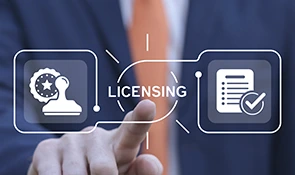
The FCVS of physician profile is a great way to expedite and simplify this time-consuming and difficult procedure.
Is applying for the FCVS worthwhile? This article aims to explore everything you should know about FCVS so that you can decide if the FCVS application is worthwhile or not. But, first, let me explain what FCVS means and how it works.
As state medical boards rely on the Federation Credentials Verification Service (FCVS) to handle primary source verification of crucial information (such as residency, medical school, board certification, etc.), the FCVS is a service provided to physicians and physician assistants that creates a lifetime collection of core credentials and simplifies the process of obtaining state medical licenses.
In short, the FCVS is a lifetime collection of credentials used to quickly and easily assess a provider's medical credentials for state licensure.
The FCVS stores all important documents so that state medical boards can quickly process a physician's application for a permanent or locum tenens license.
The list of medical documents includes a medical school diploma; an ECFMG certificate; a certificate for the Fifth Pathway; GME completion documents like residency and fellowship certificates; licensing examination history; certifications from the ABMS Specialty Board; identity documents including names such as a birth certificate or passport; and the history of disciplinary acts.
You will need to go through the process of the FCVS verifying all of these documents with primary sources in order to have a complete FCVS profile.
You can use your profile to apply for medical licenses once verification is finished, and you will get the FCVS number.
Your FCVS number is a one-of-a-kind identification number that you provide when you start an application on the FCVS portal page and set up your account. After logging in, your FCVS number will be displayed in the portal in the top right corner.
No, because FCVS stores medical credentials indefinitely, they never expire.
However, if you complete a residency or fellowship, receive Board certification, etc., you will be required to update your profile.
As mentioned already, a physician's identity, medical school diploma and transcript, postgraduate training, exam scores, ECFMG, Fifth Pathway, and ABMS board certifications are verified by FCVS credentialing.
In order to certify the diploma and have the medical school dean complete verification of the Medical Education form, FCVS sends a verification request to the school.
Your physician credential verification is complete after receiving confirmation.
The FCVS exam history process involves contacting the appropriate organizations, such as the Licentiate of the Medical Council of Canada (LMCC), the National Board of Osteopathic Medical Examiners (NBOME), and the United States Medical Licensing Examination (USMLE), to request confirmation of the exam status (pass/fail).
It depends on your state license, whether you are an MD or DO, and whether you are a foreign medical graduate.
Physicians are actually required to use the FCVS in the following states:
Kentucky, Louisiana, Maine (only medical doctors are required), Massachusetts, New Hampshire, New York (only international medical graduates are required), Nevada (only osteopathic doctors are required), North Carolina (only international medical graduates are required), Ohio, Rhode Island, South Carolina, Utah (only osteopathic doctors are required), U.S. Virgin Islands, and Wyoming.
All physicians applying for state licenses where it is required (KY, LA, ME, NH, NV (DOs), OH, RI, SC, UT, USVI, and WY) and those planning to work as a locum tenens in more than one state are required to have FCVS.
Likewise, remember that regardless of whether you fall into any of the classifications above, having an FCVS profile regularly makes the permitting system quicker than without.
The first step in applying for the FCVS is to create an account on the website of the Federation of State Medical Boards (FSMB). After creating an account, fill in the FCVS portfolio application, upload the photocopy of your diploma with specific dimensions (8.5” x 11”), pay the fee, and submit. The FSMB should process your application within 45 days or less after receiving it.
The FCVS for medical licensing is a great way to shorten the time it takes to get licensed, and many states require it as part of the medical license application.
Establishing your profile will be especially helpful if you work as a locum tenens, practice telemedicine in multiple states, or are an international medical graduate, despite the fact that completing the initial FCVS application can take months.
In case you need expert advice, get in touch with the Credidocs team.

If you intend to practice medicine in California, you will first need to complete the process of getting your California doctor license. Many of us know that it can often seem like a daunting expense of paperwork, categories, deadlines, and continuing education. We will try to simplify the complex requirements into manageable language and share what every new and established physician must know before they can apply for a California medical license.
California has one of the largest and most diverse patients' populations in the United States. California offers its practitioners world-class hospitals, research institutions, and readiness for expanding healthcare needs. Practicing in California opens the door to countless opportunities. However, getting licensed in California isn't just about doing paperwork, but showing competency, accountability, and a commitment to lifelong learning.
Before you apply for a California medical license, you need to make sure you meet the basic requirements. These typically include:
For international medical graduates, the process usually requires additional verifications and can take longer. So planning ahead is key.
One of the core elements of maintaining an active medical license is completing continuing medical education (CME). The cme licensure requirements in California are clear but strict:
Failing to meet California CME requirements can lead to delays in renewal or even suspension of practice rights.
A medical license in California is generally valid for two years. Renewal requires:
What’s important to note here is that California’s Medical Board takes non-disclosure very seriously.
When you decide to apply for a California medical license, it is not something you can wrap up in a week. Here’s a realistic timeline:
On average, this process takes about 3 to 6 months, though it may be longer for international graduates.
One of the challenges doctors often face is balancing a busy practice with continuing education. Tools like online CME courses, hospital-sponsored workshops, and national conferences can help fulfill California CME requirements without disrupting your work schedule.
Physicians often run into repeat issues when handling their medical license:
Keeping a personal checklist and updating documents as you go along removes a lot of these roadblocks.
Beyond just checking boxes for the cme licensure requirements in California, compliance shows a physician’s dedication to patient safety and professional development. California has some of the strictest standards nationally; it aligns with the state’s long-standing emphasis on patient rights and quality of care. A lapse in compliance does not only mean fines or suspensions, but also risks to your professional reputation.
Securing your California doctor license and understanding the CME requirements are crucial for maintaining a successful career in the state. Stay proactive, document each step, and set reminders for renewals. Prepare everything in advance, from exam transcripts to CME logs, as California values competency. Being licensed here means joining one of the largest and most dynamic medical ecosystems in the country.

Physician license renewal is an important step that makes sure they can still practice medicine legally. In the rapidly changing field of healthcare, it can be hard to keep track of when and how to renew your medical license. Medical licensing services are very important for making the process of renewing a doctor's license faster and easier. These businesses offer a lot of different ways to make sure that doctors never miss a renewal deadline, which keeps their Arizona state medical license (or other state licenses) in good standing. In this blog we'll go into more detail about how these services work and why they are so important for doctors in this blog.
The journey from medical school graduation to a full-fledged practicing physician involves passing exams, completing residency, and earning state licensure. But the process doesn’t end there. Every few years, doctors must prove their credentials and continuing education to renew their license. If you miss this deadline, you might face fines, disciplinary action, or even suspension of your practicing privileges. Beyond the personal stress, such interruptions risk continuity of care for thousands of patients.
Patient Trust: An active license reassures patients their doctor is in good standing.
Legal Compliance: Practicing on an expired license can result in fines or criminal penalties.
Hospital Privileges: Many facilities revoke admitting and operating rights if your license lapses.
Given these stakes, having a robust system for physician license renewal is non-negotiable.
Medical licensing services offer a streamlined approach to physician license renewal. They handle the logistics, paperwork, and deadlines involved in the renewal process, saving physicians time and stress. These services can guide you through all the steps necessary to maintain a valid medical license, such as:
1. Monitoring Renewal Deadlines
Licensing services keep track of when doctors need to renew their licenses. It's easy for doctors to forget about the renewal process when they have so many other things to do. These services send regular reminders to make sure that doctors don't miss the deadline for renewing their medical license.
2. Managing Continuing Education Requirements
Most states, including Arizona, require doctors to earn a set number of continuing education (CE) credits in order to keep their medical license. Medical licensing services make sure that doctors know what they need to do and assist them finish their required classes on time. They might even help you get into recognized CE classes, which would make the procedure as easy as possible.
3. State-Specific Guidance
Each state has its own rules for getting a license. For instance, medical licence renewal in Arizona takes different paperwork and steps than renewing a license in other states. Medical licensing services know all the details of each state's licensing rules, so they can make sure that all paperwork is filled out correctly and sent in on time. This lowers the risk of mistakes or missing information that could slow down the renewal process.
4. Handling Paperwork and Forms
It might be hard to keep track of all the paperwork that comes with medical licence renewal. The process can be long and frustrating because it requires a lot of forms, fees, and supporting documentation. Medical licensing services take care of the paperwork, making sure that all the right forms are filled out correctly and sent in on time. This helps the renewal process go smoothly and keeps processing from taking too long.
Medical licensing services don’t just prevent missed renewals; they deliver broader advantages:
Time Savings: Physicians report reclaiming dozens of hours annually that would otherwise be wasted chasing down paperwork.
Cost Efficiency: While services charge fees, those often pale compared to fines for late filings or loss of revenue from temporary suspension.
Peace of Mind: Delegating complex compliance tasks frees mental bandwidth for patient care, research, or personal life.
Timely physician license renewal is essential for practicing medicine legally and delivering quality care. Medical licensing services streamline the process by tracking deadlines, managing continuing education, and handling state-specific regulations. These services help physicians stay on track with their license renewal, including the Arizona state medical license, saving time, reducing stress, and ensuring compliance, allowing them to focus on providing excellent patient care.
Get in touch with Credidocs team as we are here to help you.

With more than 566,000 active physicians in the United States as of January 2025, holding an active medical license is more important than ever. The renewal process varies from state to state, and physicians within the state of Arizona renew their licenses biennially. If you’re a practicing doctor in the state, understanding the ins and outs of Arizona medical license renewal is essential to ensure uninterrupted practice and compliance with the law.
Renewal of the license is not only a routine process. It is important in maintaining professional standards and public confidence. Here are the reasons why it is really important to maintain your Arizona medical license renewal:
1. It's a Legal Requirement
The Arizona Medical Board requires physician licenses to be renewed every two years, prior to your birthday. Failure to meet the deadline will result in penalties or automatic suspension of your license.
2. Professional Credibility
Having an active Arizona medical license guarantees patients, hospitals, and institutions that you are up to state standards. Letting your license expire may lose you hospital privileges, insurance authorization, or the privilege to practice.
3. Continued Learning Through CM
Arizona mandates the taking of Continuing Medical Education (CME) by licensees in an attempt to be current with modern medical developments. This will guarantee that practitioners are in their optimal levels of practice.
4. Public Safety
Renewals also provide a platform for the Medical Board to examine a physician's file and set any disciplinary issues, thereby ensuring public safety and responsibility.
5. Avoiding Disruptions
A suspension of your Arizona medical license can result in you being unable to practice and potentially lose business. Staying current prevents such disruptions.
To enjoy a smooth process, ensure that you take these key steps:
1. Renew Early Enough Before Expiration Date
Arizona sends reminders of renewals around 60 days prior to expiry date, but don't wait for reminders. Remind yourself and arrange beforehand in order not to procrastinate or face technical issues at the last minute.
2. Update Your Information
Ensure that all contact data, residence and work addresses, email address, telephone numbers, and specialty area updates are up-to-date. Outdated information might delay or deny your renewal.
3. Answer Honestly and Read
You will be questioned regarding disciplinary action, malpractice, or criminal history. Untrue or misleading replies can result in drastic measures like denial of renewal.
4. See a Lawyer if Necessary
If unsure whether to report some information (e.g., previous discipline), consult an attorney. They can assist with completing your case correctly and professionally.
5. Ask for Guidance if Lost
In case you are lost as to requirements or are having trouble filling out the form, call the Arizona Medical Board. There are also third-party services such as CrediDocs that may assist with a simple application process without any hassle.
As with dos, there also are don'ts that you must avoid:
1. Do Not Give False Information
Minor differences, whether deliberate or inadvertent, can prompt investigations and slow down the renewal process.
2. Never Leave Out Disclosures
Leaving out legal or disciplinary problems can result in fines or suspension. Tell the truth at all times.
3. Don't Forget to Update Your Email
If your personal information changes, particularly your email, let the board know. An old email may result in lost notices and missed deadlines.
4. Do Not Attend Unprepared
In case of being called for hearing or review, do not attend unprepared. Pack your relevant documents and get legal counsel to project professionalism and readiness.
Renewing your Arizona medical license is not only a requirement but it's your duty to hold on to your right to practice medicine and provide good quality care. By following these instructions on do's and don'ts, you'll be able to have a smooth renewal process.
Missing deadlines or even careless errors can cost you your professional career. If you require professional assistance with renewing your medical license smoothly, consider hiring the services of firms like CrediDocs that can streamline and facilitate the process for you.
Coprights ©2025 CrediDocs. All Rights Reserved Privacy Policy Terms & Conditions
Coprights ©2025 CrediDocs. All Rights Reserved